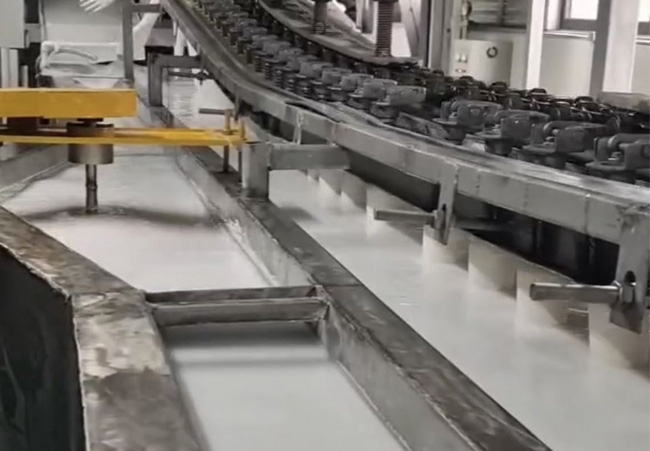Latex gloves manufacturing machinery is used for producing latex gloves, from raw materials to finished product packaging. Fengwang’s latex gloves manufacturing machinery has been continuously designed and improved, giving its products unique advantages. Below is a detailed description of the characteristics of latex glove making machines.

High Production Efficiency
The latex glove production line comes in single-row and double-row designs. A double-row latex glove production line typically produces hundreds of gloves per minute. A complete production line may be equipped with 1,000 to 2,000 hand molds, with each mold completing steps such as dipping, vulcanization, and demolding in a single cycle. Additionally, latex glove production equipment supports 24/7 uninterrupted operation, maximizing production capacity.
High Automation
Traditional latex glove production involves steps such as material handling, hand mold cleaning, dipping, beading, vulcanization, demolding, washing, drying, and packaging. Smart latex glove production lines integrate these steps into an automated, high-efficiency latex glove production line, reducing manual intervention and improving production efficiency.
Versatility
The latex glove production line can produce gloves of different sizes (S, M, L, XL, etc.) and types by replacing hand molds and adjusting parameters. For example, medical examination gloves are usually thinner, while industrial gloves are thicker and more wear-resistant. Additionally, some equipment can also produce synthetic latex gloves (such as nitrile rubber gloves), meeting diverse market demands.

Precise Control
During the dipping process, the latex glove production line ensures uniform glove thickness by precisely controlling dipping time, dipping depth, and latex concentration in the dipping tank. Typically, medical examination gloves have a thickness of 0.08-0.12mm, while industrial gloves are thicker. The vulcanization process enhances the elasticity and strength of gloves by precisely controlling temperature and time, allowing latex molecules to cross-link.
Energy Efficiency and Environmental Protection
The latex glove production line uses efficient heating systems (such as electric or steam heating) and energy-saving motors to reduce energy consumption. For example, vulcanization ovens are insulated to minimize heat loss. Wastewater generated during production (e.g., from cleaning hand molds) is treated through sedimentation, filtration, and chemical processes for reuse, reducing environmental pollution. Exhaust gases (e.g., ammonia) produced during vulcanization are purified through exhaust gas treatment systems (such as activated carbon adsorption or catalytic combustion) before emission, complying with environmental standards.
High Hygiene Standards
The production environment for medical latex gloves must meet hygiene standards. Latex glove production machines feature enclosed designs to minimize external contamination. Parts of the equipment that come into contact with latex are made of stainless steel or other non-toxic materials to avoid product contamination.

Durability
Key components of the equipment (such as hand molds, conveyor chains, and dipping tanks) are made of stainless steel or high-strength alloys, offering corrosion resistance, wear resistance, and a long service life. The equipment is designed for easy maintenance. For example, hand molds are modular and can be quickly replaced if damaged, minimizing downtime.
High Safety
The equipment is equipped with emergency stop buttons, overheating protection, overload protection, and other safety devices to ensure operator safety. High-temperature areas (such as vulcanization ovens) are enclosed to prevent operators from coming into contact with hot components.
Modular Design
Users can add or remove modules (such as dipping tanks, vulcanization ovens, and packaging machines) as needed, allowing flexible adjustment of the production line. As technology advances, equipment performance can be improved by upgrading modules (such as more efficient control systems or energy-saving components).

Glove Counting Machine—One of the Most Important Processes
Fengwang’s glove counting machine plays a crucial role in quickly and accurately counting and packaging finished gloves. It is one of the most important machines in the latex glove production line. Below are the key functions of the glove counting machine.
Improves Production Efficiency
The glove counting machine can accurately process hundreds or thousands of gloves per minute, far exceeding the efficiency of manual counting.

Ensures Accurate Quantities
The glove counting machine uses advanced sensors and counting technology to ensure accurate glove counts during operation, avoiding errors.
Reduces Labor Costs
The use of counting machines significantly reduces the need for counting and packaging personnel, thereby lowering labor costs. The operation of the counting machine is simple, and employees only require basic training to get started, eliminating the need for complex skill development.
Adapts to Diverse Needs
The counting machine can adjust the number of gloves per package (e.g., 50 gloves/package, 100 gloves/package) to meet the requirements of different customers. The equipment is suitable for various types of gloves, including latex, nitrile, and PVC gloves, offering strong versatility.
Supports Large-Scale Production
The counting machine can seamlessly integrate with high-speed production lines, meeting the demands of large-scale production and ensuring that the production rhythm is not interrupted.
High Stability
The equipment operates stably with a low failure rate, capable of continuous long-term operation, making it suitable for the production of large-volume orders.

Summary
The glove stacking machine plays a crucial role in latex glove production. It not only improves production efficiency and ensures accurate counting but also reduces labor costs, enhances packaging quality, and elevates the corporate image.


